10 Classroom Resources Every Educator Needs
In today’s classrooms, the right tools can transform teaching and learning. From digital platforms to traditional supplies, these resources enhance lesson delivery, student engagement, and classroom organization. Here’s a quick overview of 10 must-have resources for K–12 educators:
- DashK12 Classroom Slide Decks: Pre-made, customizable presentations covering subjects like business, entrepreneurship, and more ($97 per bundle).
- DashK12 Self-Paced Courses: On-demand professional development in topics like sales techniques and teaching diverse learners ($197 per course).
- Basic Stationery and Organizational Supplies: Essential items like binders, markers, and storage bins to keep classrooms efficient.
- PBS LearningMedia: Free digital resources, including lesson plans and interactive tools, aligned with national standards.
- National Geographic Education: Free, visually rich materials like maps, videos, and live Explorer sessions for grades Pre-K–12.
- Science Buddies: Over 1,200 free STEM projects and 200 NGSS-aligned lesson plans for hands-on science learning.
- ReadWriteThink: Free literacy-focused lesson plans, strategy guides, and interactive tools for grades K–12.
- Kahoot: A game-based learning platform for quizzes, assessments, and interactive lessons (free basic version).
- GoNoodle: Free movement and mindfulness activities to re-energize students and improve focus.
- DashK12 E-Books and Exclusive Photography: Digital books and high-resolution images tailored for classroom use.
These tools cater to diverse teaching styles, grade levels, and subjects while saving educators time and effort. Whether you’re planning lessons, managing your classroom, or enhancing student participation, these resources offer practical solutions to common challenges.
Best Online Resources for Teachers
1. DashK12 Classroom Slide Decks
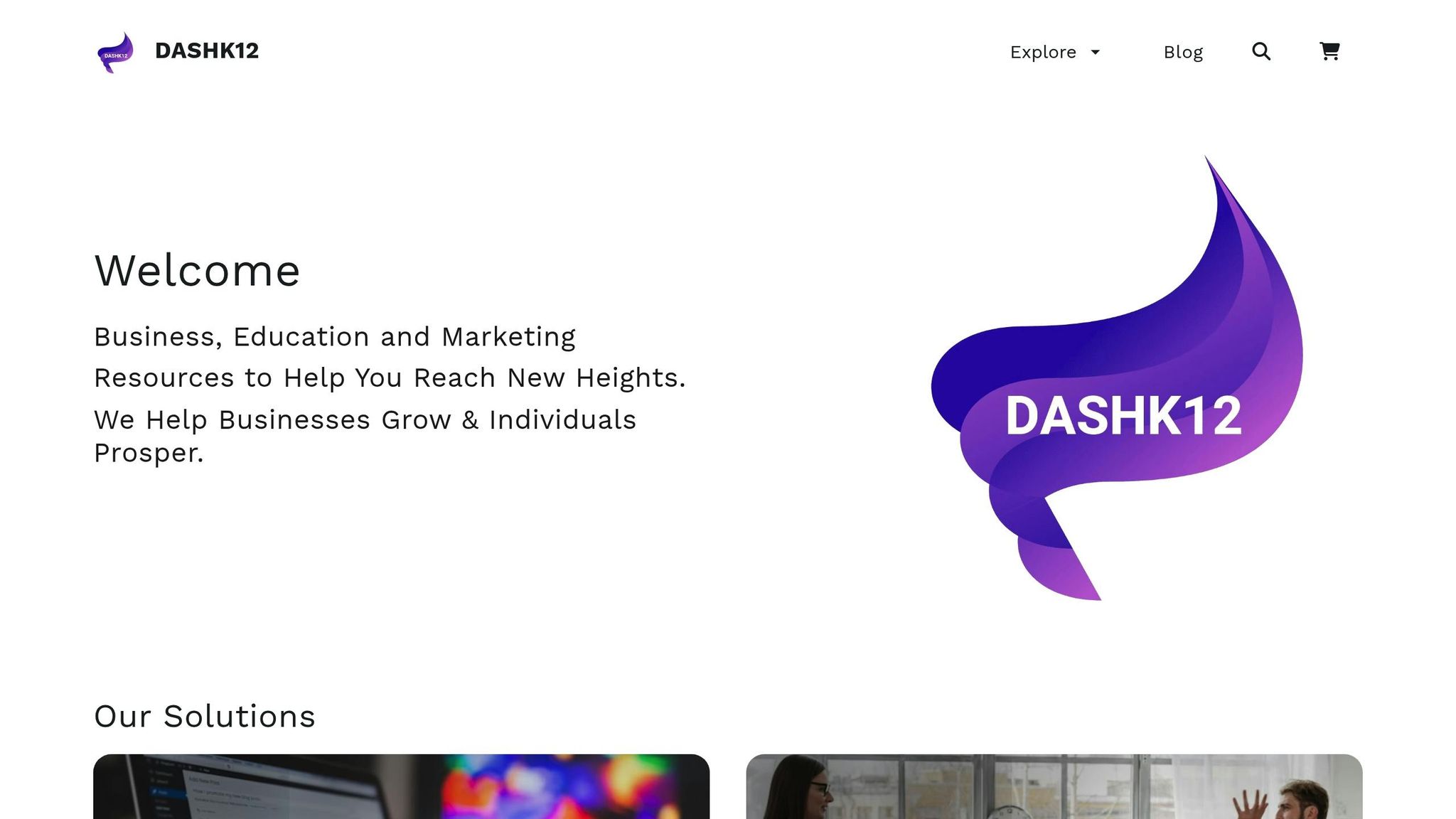
DashK12 Classroom Slide Decks offer ready-made, fully customizable presentations designed to make lesson planning easier and more effective. These pre-designed slides let you skip the hassle of creating presentations from scratch, so you can focus on what matters most - teaching.
The platform covers a range of subjects, such as business management, sales training, entrepreneurship, and even the Bible. For instance, the Practicum in Entrepreneurship Slide Decks Bundle includes 49 individual slide decks with over 400 slides. These are specifically aligned with Texas Essential Knowledge and Skills (TEKS) standards for grades 11–12, ensuring relevance and quality.
What makes these decks stand out is their flexibility. You can tweak colors, fonts, images, and content to align with your teaching style or adapt them to different grade levels. Whether you want to simplify the material for younger students or add advanced examples for older ones, the decks are easy to adjust.
Each bundle also comes with a Slide Deck Guide PDF, packed with tips on how to implement the slides effectively and keep students engaged. The bundles are priced at $97 and include options like:
- Practicum in Entrepreneurship Slide Decks Bundle
- Business Management Slide Decks Bundle
- Sales Training Slides Bundle
- The Bible Slide Decks Bundle
Looking for more tools to enhance your teaching? Check out the DashK12 Self-Paced Courses next!
2. DashK12 Self-Paced Courses
DashK12 Self-Paced Courses are designed to help educators build new skills on their own schedule. These courses are available anytime, making it easy to fit learning into even the busiest routines.
Each course focuses on practical strategies that can be applied in the classroom right away. You'll find quizzes to test your knowledge and additional resources to deepen your understanding.
Some of the most popular topics include advanced sales techniques, professional communication skills, and detailed guides for teaching Career and Technical Education (CTE). Priced at $197, these courses also come with a printable certificate and transcript - perfect for boosting your professional development in business and CTE fields.
One standout course, "Reaching Diverse Learners", has received glowing reviews, earning five stars from 91 participants. It offers actionable strategies for teaching English Language Learners (ELLs) and managing diverse classrooms effectively.
The lessons are concise and feature short, rewatchable videos to keep you engaged and help you retain what you’ve learned. This self-paced, flexible format is also more budget-friendly than traditional professional development since it skips the costs of venues, instructors, and materials.
Up next, we’ll dive into tools that simplify classroom organization.
3. Basic Stationery and Organizational Supplies
While digital tools often steal the spotlight, the backbone of any effective classroom still depends on basic stationery and organizational supplies. These everyday essentials keep things running smoothly and ensure students stay focused on learning rather than hunting for missing materials.
The right supplies make a difference. Quality tools for note-taking, managing assignments, and encouraging creativity can improve student organization and motivation. In fact, research highlights that handwriting enhances memory retention and learning. These basics not only support traditional handwritten tasks but also complement digital tools, creating a balanced learning environment.
As ArtzFolio.com puts it:
"Investing in quality stationery is an investment in a student's academic success."
Here’s a breakdown of must-have classroom supplies:
- For teachers: Items like binder clips, copy paper, electric pencil sharpeners, highlighters, index cards, markers, paper clips, pens, pencils, scissors, sticky notes, staplers, and tape.
- For organization: Tools such as adhesive tabs, binders, bins, file folders, labels, page protectors, and plastic drawers.
- For students: Supplies including colored pencils, composition notebooks, erasers, folders with prongs, glue sticks, individual dry-erase boards, and spiral notebooks.
A well-organized classroom doesn’t just save time - it reduces frustration. Using clear, labeled bins and assigning specific storage areas for different categories of supplies ensures everything is easy to find and keeps the classroom running efficiently.
Beyond just tidiness, investing in quality supplies sends a powerful message. Durable materials mean fewer interruptions from broken pencils or dried-out markers, and they show students that their education is valued. As EON Office explains:
"When a teacher fosters a caring and supportive learning environment, learners are more likely to stay engaged and succeed academically. Providing students with high-quality classroom supplies they can use now and into the future emphasizes the importance of their success. By investing in superior products, you are expressing an investment in their education."
Next, we’ll explore how digital tools can build on these foundational strategies to further enhance learning.
4. PBS LearningMedia
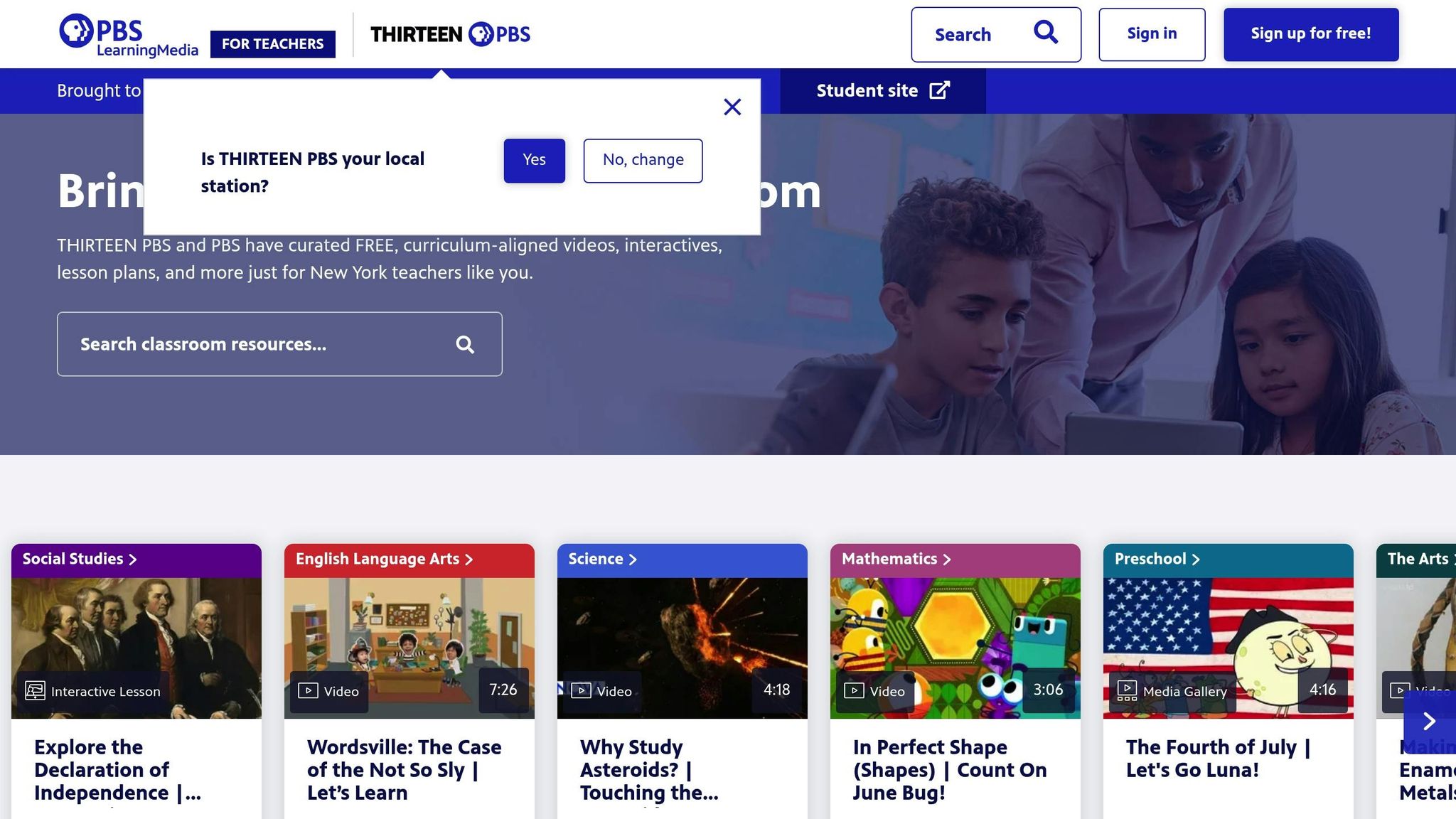
PBS LearningMedia is a treasure trove of free, curriculum-aligned digital resources for K–12 educators. With access to over 100,000 resources - ranging from videos and interactive lessons to detailed lesson plans and multimedia content - it covers every subject and grade level imaginable. Plus, all materials align with national and Common Core State Standards.
As PBS describes it:
"With PBS LearningMedia, Pre-K through 12th grade educators can access thousands of free, classroom-ready resources to help customize their instruction and personalize learning experience for their students."
The platform integrates seamlessly with tools like Google Classroom, Clever, Schoology, and Remind. Educators can also use its built-in Lesson Builder to craft and assign media-rich lessons tailored to their students' needs. These features make it easy to bring PBS content directly into the classroom.
The real magic happens when these resources come to life in the classroom. For instance, the Leonardo da Vinci collection for grades 6–12 connects students to Ken Burns' documentary, offering insights into da Vinci's groundbreaking work in art, science, and engineering. This collection shows how PBS content can enhance everyday lessons. For younger learners, the "Carl the Collector" collection provides videos and activities that encourage inclusive learning practices.
Special Education Teacher and 2020 PBS Digital Innovator All-Star Clemencia Acevedo praises the platform’s flexibility:
"PBS LearningMedia is full of rich and engaging resources available in all grade levels and subjects. My favorite part of the platform is that you can use the 'filter by feature' tool to narrow your search by grade level, subject, resource type, and language."
The platform’s interactive features are designed to hold students’ attention. Videos work as engaging hooks, while tools like interactive maps and the distraction-free "focus view" help students stay on track.
For educators tackling sensitive subjects, PBS LearningMedia provides extra support. Its "Hiding in Plain Sight" collection addresses youth mental health with discussion guides and language resources. Similarly, KQED's "Above the Noise" series offers materials to help students develop critical thinking skills around complex issues. These resources give teachers the tools they need to guide meaningful and effective conversations.
Planning lessons is also a breeze thanks to the extensive support materials available. Acevedo highlights this benefit:
"Teachers can build a whole lesson or unit plan by incorporating all resources available because there are so many options teachers can select from. My biggest advice is for teachers to use the support materials for teachers and support materials for use with students. They are put together by teachers with long years of teaching experience!"
Up next, we’ll explore how to bring the world into your classroom with engaging geography and science content.
5. National Geographic Education
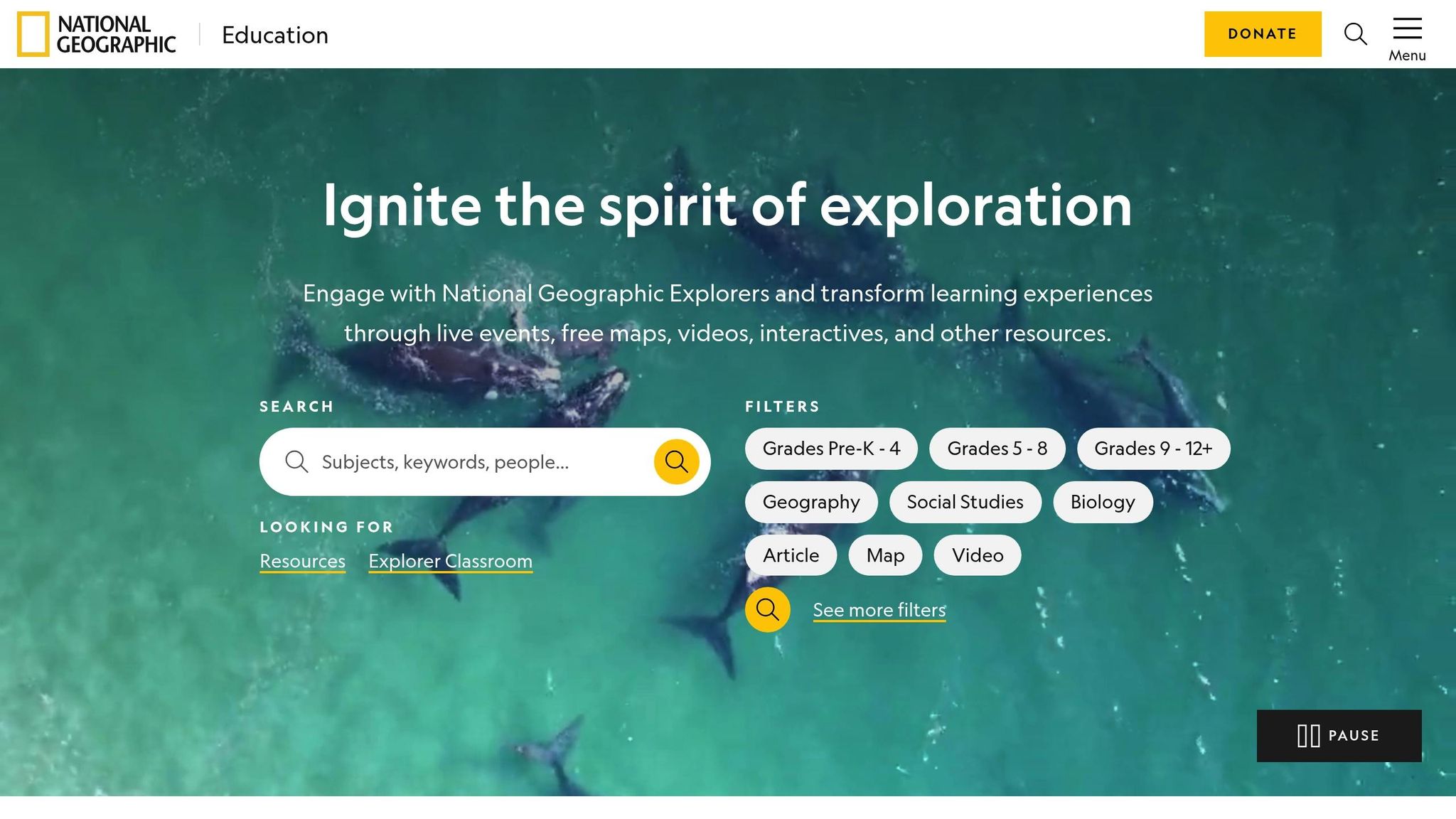
National Geographic Education brings a world of discovery into classrooms, offering a treasure trove of 2,700 free resources for students from pre-K through grade 12. The platform combines its iconic photography, in-depth research, and interactive tools to "ignite the spirit of exploration" in learners. Designed to foster curiosity, it provides educators with practical, visually rich materials that make learning an adventure.
One standout feature is the variety of content formats available. Teachers can access everything from live events and interactive maps to videos, lesson plans, and photographs. These resources cover a broad range of topics, including geography, social studies, biology, earth science, anthropology, and current events. The Resource Library further expands these offerings with activities, articles, educator guides, games, maps, and more.
Another engaging program is the Explorer Classroom, which connects students with National Geographic Explorers in real time. For example, during the 2023–2024 school year, Explorer Katlin Bowman Adamczyk hosted a session titled Expedition to an Active Volcano for grades 3–8. She shared her research from Santorini, Greece, and discussed how scientists predict volcanic eruptions. Similarly, Explorer Ru Somaweera led The Fantastic World of Reptiles, where students learned how herpetologists study snakes and other reptiles in their natural habitats.
The MapMaker Interactive tool is another gem, allowing students to create custom maps, track historical changes, and design projects that make geography come alive. This hands-on approach not only enhances understanding but also inspires creative science projects.
For younger learners, Explorer Magazine offers grade-specific content for K–5/6, complete with teacher guides and digital materials available in both English and Spanish. These resources simplify complex geographic and scientific ideas, making them digestible for elementary students.
Jenny Bristol from Common Sense Education captures the platform's impact perfectly:
"This is a must-bookmark site for classrooms across the curriculum hunting for inspiring place-based resources."
To make lesson planning easier, the platform includes bookmarking and collection tools, allowing educators to organize materials by topic or class. Whether you're looking for a quick map for homework or planning a full unit with MapMaker projects, National Geographic Education provides everything needed to create meaningful and engaging lessons.
Next, we’ll dive into ways to make science experiments exciting and accessible for students of all ages.
sbb-itb-4f1eab7
6. Science Buddies
Science Buddies is a treasure trove for STEM enthusiasts, offering a wealth of resources to bring hands-on science learning to life. The platform features over 1,200 free science projects and more than 200 lesson plans aligned with NGSS standards, making it easier for educators to incorporate STEM into their classrooms - whether in-person, hybrid, or remote settings.
One standout feature is the Topic Selection Wizard, which helps students find projects tailored to their interests and available materials. With 32 categories ranging from life sciences to space exploration, projects are also sorted by grade level, cost, and time commitment, ensuring there's something for everyone.
Affordability is a key focus, with most projects costing under $20. Examples of engaging activities include building a Balloon-Powered Car, creating a Floating Maglev Train, constructing the Tallest Paper Tower, and even turning a potato into a battery to explore chemical reactions.
Karen Kelly, a teacher at Clayton Valley High School, shared her experience:
"I'm using your website as a 'one-stop shopping' site for my students as they work on their science projects. Your site has improved so much and it's going to make doing Science Fair projects so much more manageable for me."
For educators, Science Buddies provides STEM classroom kits complete with lesson plans, teacher guides, assessments, and tools that integrate seamlessly with Google Classroom. The platform also offers comprehensive science fair resources, including grading rubrics, scorecards, and scheduling guides.
To streamline lesson planning, the Teaching Science Units page features curated collections of themed lesson plans that can be bookmarked for quick reference. Whether it's a simple experiment for elementary students or a complex engineering challenge for high schoolers, Science Buddies supplies teachers with the tools and support needed to make STEM learning exciting and accessible for all.
7. ReadWriteThink
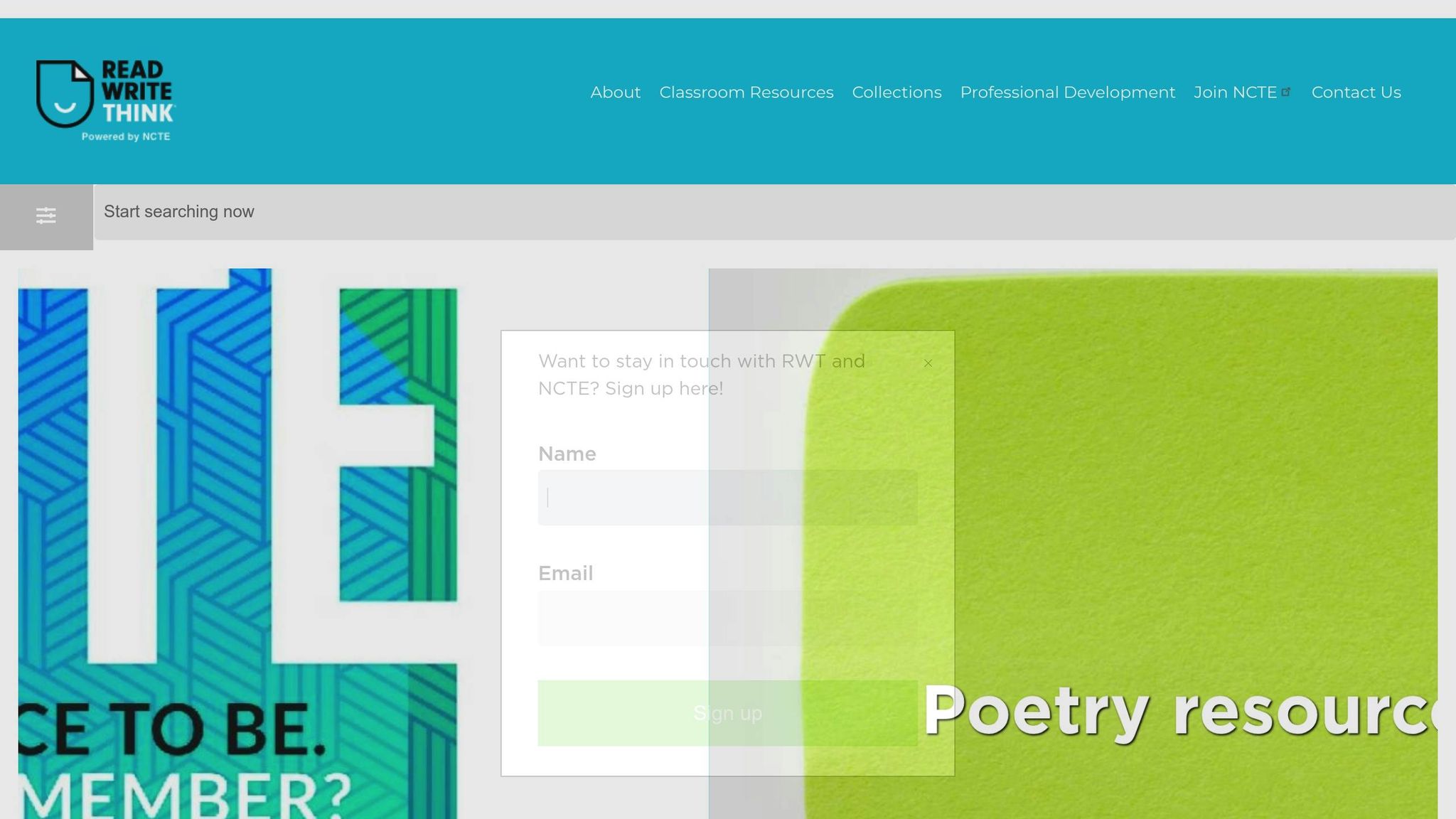
ReadWriteThink is a treasure trove for educators looking to enhance literacy instruction in their classrooms. Developed by the National Council of Teachers of English (NCTE), this platform offers free, standards-aligned lesson plans and instructional materials for K–12 educators. All resources are designed to meet IRA/NCTE, state, and Common Core standards, ensuring they fit seamlessly into your curriculum.
The platform’s user-friendly filtering system allows teachers to sort materials by grade level, topic, resource type, or learning objective. From quick minilessons to comprehensive units, printable worksheets, and interactive activities, ReadWriteThink provides a wide array of tools to support literacy education. These resources pair well with the interactive tools mentioned earlier, offering a digital edge to classroom learning.
One standout feature is the strategy guides, which cover teaching approaches ranging from traditional literacy methods to integrating technology like blogs, podcasts, and online safety lessons. Additionally, interactive tools such as the Venn Diagram, Word Mover, Trading Card Creator, and Story Map help students organize their thoughts and summarize information effectively. For classrooms with diverse learners, the platform includes bilingual resources, such as activities using Spanish-English picture books, which help second-grade English Language Learners (ELLs) identify main ideas and practice writing through creative tasks.
Teachers often praise ReadWriteThink for its high-quality, flexible resources that cater to a wide range of grade levels. A unique feature is its literacy calendar, which links significant literary events, author birthdays, and holidays to classroom activities. This makes it easy to incorporate timely and relevant content throughout the school year. Whether you're facilitating literature circles, exploring genres, or blending science trade books with literacy lessons, ReadWriteThink offers structured, research-backed strategies to create meaningful learning experiences.
8. Kahoot
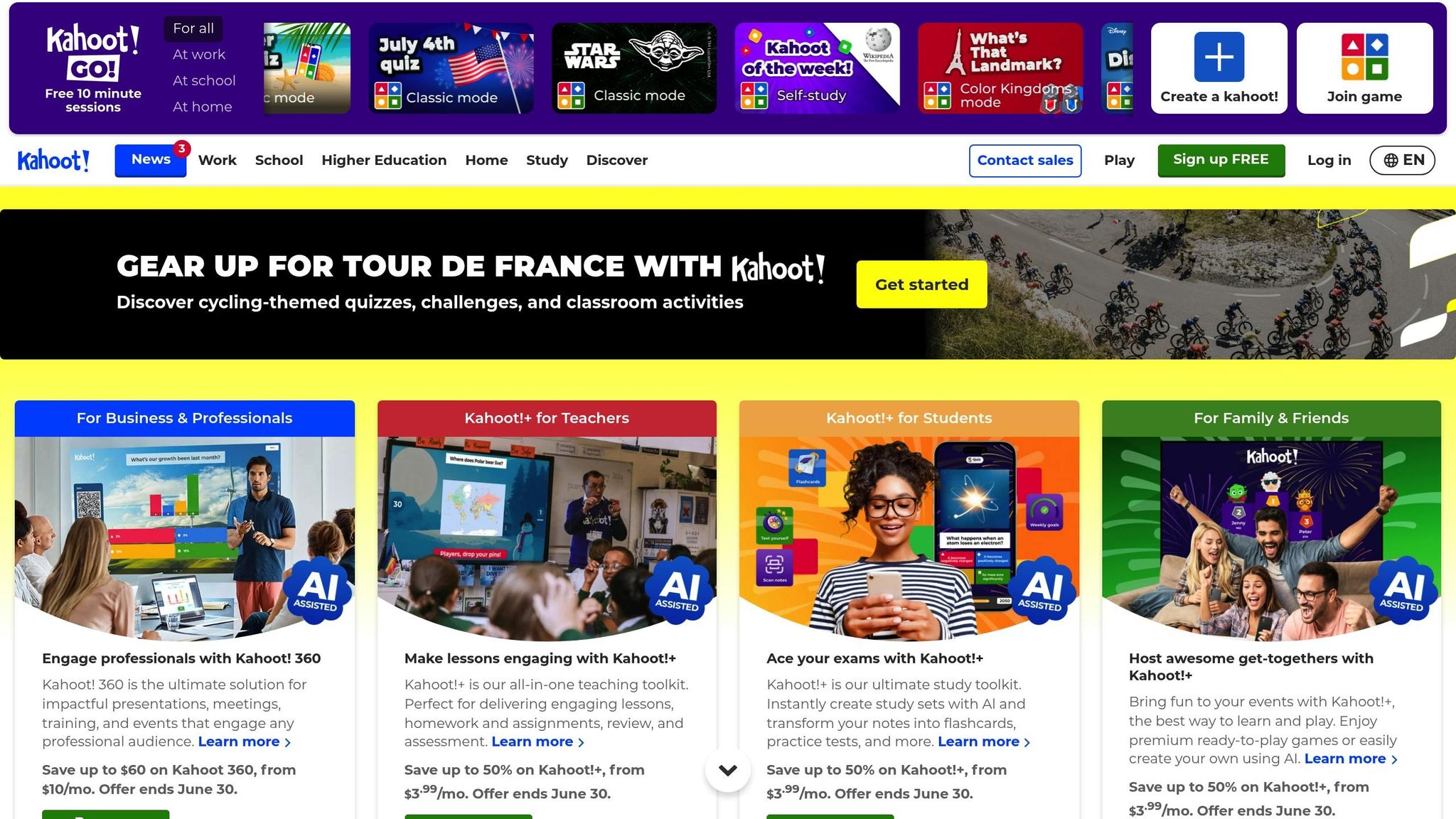
Kahoot turns classrooms into lively, interactive game shows. With over 8.6 million educators worldwide using the platform, it’s become a staple in U.S. classrooms, engaging around 20 million elementary and middle school students.
Christine Elgersma highlights how Kahoot shakes up traditional teaching methods to keep students engaged. It creates a unique blend of individual participation and group interaction, as Louisa Rosenheck explains:
"At its core, Kahoot! is a social experience - everyone gets to answer for themselves, but they are part of a larger group having a shared experience, so it strikes the right balance of independence and community."
Teachers can use Kahoot in various ways, whether as a pre-assessment to gauge student knowledge before diving into a new topic or as a quick "exit ticket" to measure learning after a lesson. Features like "Blind Kahooting" even help introduce new concepts in a fun and engaging way.
Kahoot has recently stepped up its game with AI-powered tools that simplify content creation. Joseph "Gab" Educado notes:
"Kahoot's AI generator quickly creates tailored, engaging questions - saving time and boosting creativity."
Studies back up its effectiveness, showing improved learning performance, participation, and test scores. In fact, 70% of significant studies report notable grade improvements.
The platform’s flexibility is another major plus. Teachers can adjust game modes, like timers or anonymous participation, and even empower students to create their own quizzes. These options cater to different learning styles while maintaining privacy. Adam Sparks, a former teacher and CEO of Short Answer, captures the excitement:
"When you walk into a room with kids playing Kahoot!, you will see all the physical signs of engagement."
Perhaps the best part? Kahoot! Basic is completely free for K–12 teachers, making it accessible to schools regardless of their budget.
Up next, explore another tool that combines movement and fun to energize the classroom.
9. GoNoodle
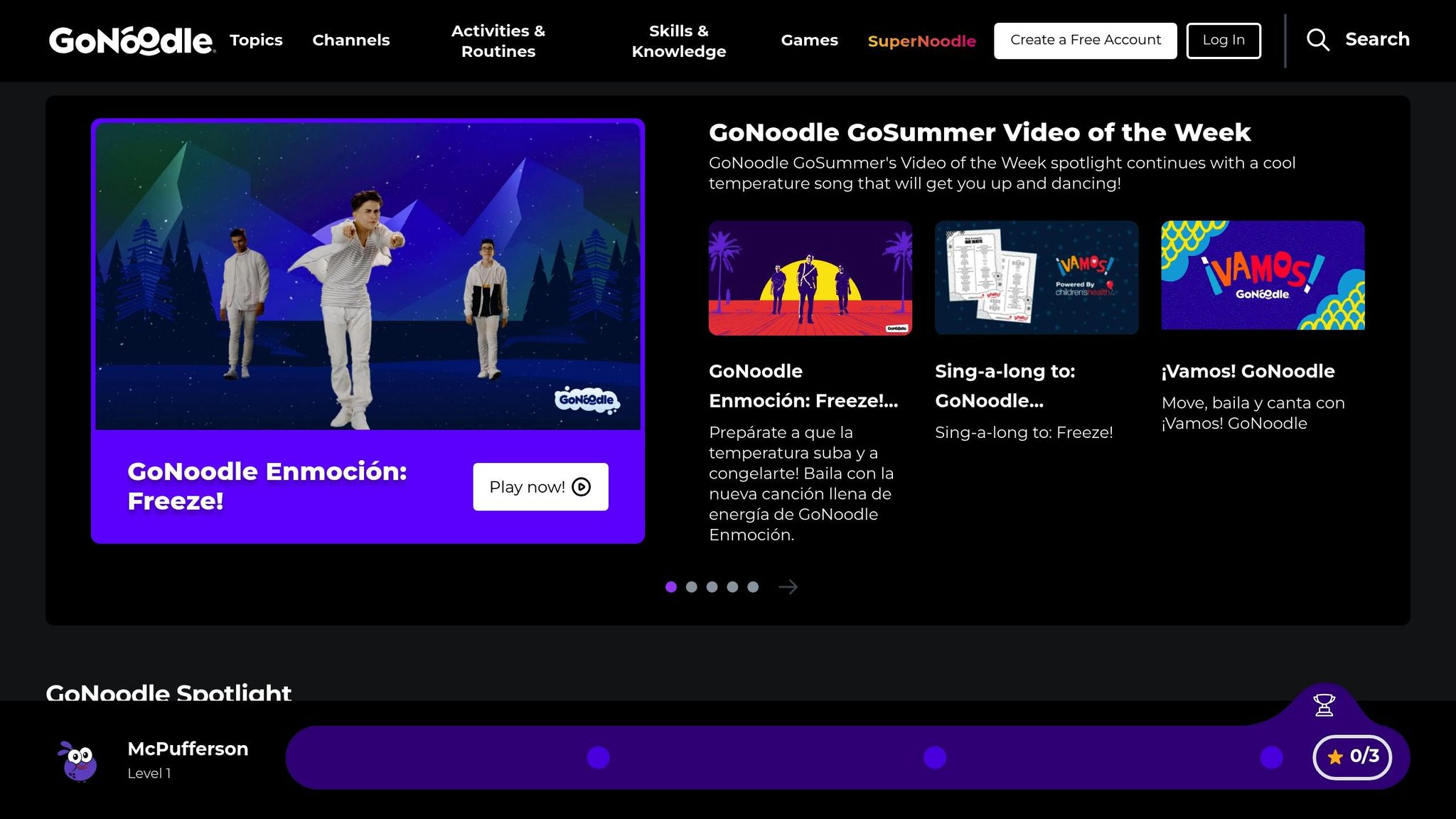
When students start to lose focus, GoNoodle steps in to bring energy back into the classroom with fun movement breaks. This free online platform offers interactive videos, dance routines, stretching exercises, and mindfulness activities, making physical activity a powerful tool for learning.
GoNoodle connects movement to the curriculum by providing content that aligns with key subjects. For example, students can count to 100 in math, explore the water cycle in science, or practice punctuation in English language arts. These activities are designed to fit into 5- to 10-minute segments, perfect for brain breaks or smooth lesson transitions.
The platform is tailored for Pre-K through 6th grade and focuses on important skills like connection, choice, creativity, courage, collaboration, and confidence. Teachers can select from breathwork, mindfulness exercises, and movement routines that enhance sensory and motor skills. These short bursts of activity not only refresh students but also boost the overall effectiveness of lessons.
Research backs the value of movement in the classroom. Lynn Pantuosco-Hensch, a professor in the Movement Science, Sport, and Leisure Studies Department at Westfield State University, highlights the benefits:
"Adding physical activity to classrooms will result in more focused, better-behaved students who can accomplish even more throughout the school day."
Teachers can use GoNoodle in various ways - kick off the day with a dance party, take quick brain breaks, or try GoNoodle Flow for mindfulness exercises. The platform even offers a Spanish-language channel to support diverse classrooms.
Miss Behavior, an education expert, emphasizes the proactive benefits of movement:
"Allowing movement breaks is a proven proactive behavior management tool – get ahead of your students and structure movement into your day!"
To make the most of GoNoodle, educators can let students pick activities, create routines for transitions, and use visual cues to keep personal space during movement. Beyond the classroom, teachers can share GoNoodle with families, encouraging use at home and even adding movement challenges to homework. Best of all, GoNoodle is completely free, removing financial barriers while improving student engagement and classroom management.
Next, dive into digital resources designed to provide comprehensive educational content and exclusive classroom materials.
10. DashK12 E-Books and Exclusive Photography
DashK12 E-Books and Exclusive Photography offer digital resources that align with K–12 curricula, designed to make classroom learning more engaging and interactive. These carefully crafted tools provide teachers with a wealth of materials to support and enhance their lessons.
The DashK12 E-Books are built for flexibility, making it easy for teachers to tailor their use based on classroom needs. Whether it’s assigning chapters as homework, using them for in-class presentations, or granting students individual access on classroom devices, the content is designed to fit seamlessly into daily instruction. Plus, the materials align with Common Core and state-specific standards, ensuring they meet grade-level learning goals and assessment requirements.
The Exclusive Photography collection is another standout feature, offering high-resolution, rights-cleared images tailored for educational use. History teachers can bring lessons to life with archival photographs of key events, while science instructors might use detailed images of ecosystems or biological processes to clarify complex topics. These visuals not only captivate students but also help make abstract concepts easier to grasp, especially for visual learners.
By combining e-books with these compelling visuals, teachers can create dynamic, interdisciplinary lessons. For example, during a social studies unit on American landmarks, students could read a DashK12 E-Book chapter on the history of the Statue of Liberty. Then, they might analyze exclusive photographs of the monument, comparing historical and modern images to create multimedia projects or timelines.
Accessibility is a core focus of DashK12’s tools. Features like adjustable font sizes, text-to-speech functionality, high-contrast modes, and alternative text descriptions for images ensure that all students, regardless of their needs, can fully engage with the content.
Globally, over 45 million students and 776,000 teachers rely on digital teaching tools that include e-books and visual resources. Educators who use these platforms report saving significant time on lesson planning, allowing them to dedicate more energy to teaching and supporting their students.
DashK12’s interface is designed with U.S. classrooms in mind, offering easy search and filtering options by grade level and subject. These resources are typically available through school or district subscriptions, with pricing in U.S. dollars and clear licensing terms for educational use. Teachers value the consistent quality, regular updates, and dedicated support behind these materials.
Educators have found that interactive e-books and visually rich resources significantly improve student engagement, understanding, and memory retention. This is particularly true for today’s digital-native learners, who thrive on multimedia content. DashK12’s offerings round out a robust set of tools that aim to empower teachers and inspire students.
Conclusion
The ten classroom resources highlighted in this guide represent the backbone of effective education in today’s K–12 classrooms. By blending digital tools like DashK12’s slide decks and e-books with reliable essentials such as organizational supplies, educators can create environments that truly address the diverse needs of their students. These tools not only align with educational standards but also help simplify classroom management.
What makes these resources stand out is their ability to adapt to various teaching styles and learning needs. For instance, platforms like PBS Learning Media offer curriculum-based content, while Kahoot provides engaging, interactive assessments. Together, they contribute to equitable learning spaces that respect and support each student’s unique journey.
Technology has undeniably reshaped the American classroom. As David Gundlach, Deputy Superintendent of Oshkosh Area School District, notes:
"Combining Google Workspace for Education with Chromebooks gave us a truly seamless, efficient, effective, and innovative learning system that supports our personalized learning environment. There is no way we could do this without using Chromebooks and Google Workspace for Education".
These resources are versatile, spanning across grade levels and subjects, and they save educators valuable time. For example, elementary teachers might use GoNoodle for movement breaks and ReadWriteThink for literacy activities, while high school educators could rely on Science Buddies for STEM projects and National Geographic Education for enriching social studies lessons. DashK12 fills the gaps by offering age-appropriate materials that cater to the entire K–12 spectrum. A science teacher, for instance, could integrate DashK12’s exclusive photography with Science Buddies for experiments and Kahoot for assessments, creating a seamless and engaging learning experience.
FAQs
How can educators tailor DashK12 Classroom Slide Decks to fit their teaching style and grade level?
DashK12 Classroom Slide Decks are built to offer flexibility and easy customization, giving educators the freedom to tailor them to their teaching style and their students' needs.
For instance, you can tweak the tone and complexity of the content to suit various grade levels or add subject-specific examples to make lessons hit closer to home for your students. On top of that, the design elements - like colors, fonts, and layouts - can be personalized to match your approach, helping to create a more dynamic and engaging learning environment.
How does Science Buddies support hands-on STEM learning in the classroom?
Science Buddies makes STEM learning come alive with ready-to-use materials that bring hands-on activities into classrooms, no matter their size. These resources help students build critical thinking and problem-solving skills through practical investigations and experiments.
Teachers can explore free guides, lesson plans, and kits crafted to actively involve students in STEM topics. With these tools, educators can design interactive lessons that spark curiosity and encourage deeper learning, making STEM subjects more engaging and impactful for their students.
How does GoNoodle use movement and mindfulness to help students stay focused and engaged?
GoNoodle brings movement and mindfulness activities into classrooms with short, interactive videos and exercises that help students focus, manage their energy, and support their emotional health. These activities are perfect for helping kids shift between tasks, stay composed, and maintain attention during lessons.
By blending lively physical activities with soothing mindfulness practices, GoNoodle offers a fun and effective way to keep students engaged and on task throughout the school day.